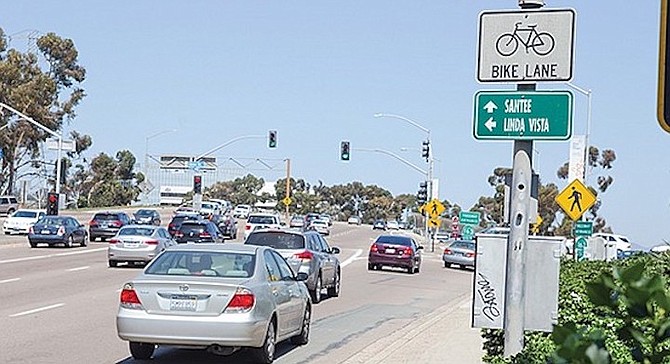 Facebook
Facebook
 X
X
 Instagram
Instagram
 TikTok
TikTok
 Youtube
Youtube

The city council on Monday voted unanimously to pass the Complete Streets policy, a plan for revamping streets to make them safer for all modes of travel.
The plan emphasizes features such as the buffered bike lanes on Park Boulevard north of University Ave. and speed reduction elements like the roundabout in Florida Canyon. All around, the thinking encourages what it calls street connectivity.
The policy could be used with city projects, new construction, private development and mobility projects between jurisdictions. It will be part of community plan updates, adding linear parks, landscaping, and bike improvements. In the mid-city, it will mean circulators, direct shuttles, and smoother transit through key areas.
But bike advocates argued the proposal puts developers in the driver's seat. "The latest language rips the teeth out of the policy," one caller said.
The city has now heard the plan twice. Critics of the draft policy had insisted on an overhaul based on exemptions they say will allow private developers to steer around its street design plans.
Additional outreach between the 1st and 2nd hearing wasn't enough to satisfy opponents, who asked for a checklist of projects and how they match to the city's climate action goals, as well as the ability to appeal publicly.
At the meeting, they complained that the exemptions remain.
"Basically, anything can qualify for an exemption."
City transportation planners downplayed exemptions to the pro-bike priorities, saying they would be "few and far between." Fiscal considerations aren't expected to be a reason for making exceptions, while emergency repairs to water mains and streets would be. Other exceptions could be things like benches, trees, and other green street features.
One example of an exemption is along Park Boulevard, where the city was unable to continue the bike lane for the entire segment of the corridor because accessible parking for handicapped was needed near the Rose Garden.
The city doesn't want to see projects come on line that don't have any features whatsoever, staff said, so the policy is about "incentivizing" designs that have greater mobility features.
A sea change, however, will be needed. The city's goals to end all traffic deaths by 2025 and cut greenhouse gas emissions to zero by 2035 depend on it.
One caller described the massive mismatch in road uses. At the corner of East Mission Bay Drive and Garnet, "50 years ago the traffic backed up maybe one block; today it's one mile."
The outcome has been lost lives.
"A Complete Street project can be the difference between life and death," said Manny Rodriguez, a volunteer with BikeSD.
The city in 2015 pledged 0 traffic fatalities by 2025. Since then, 428 people have been killed — including a pedestrian struck today by multiple cars on Interstate 805.


The city council on Monday voted unanimously to pass the Complete Streets policy, a plan for revamping streets to make them safer for all modes of travel.
The plan emphasizes features such as the buffered bike lanes on Park Boulevard north of University Ave. and speed reduction elements like the roundabout in Florida Canyon. All around, the thinking encourages what it calls street connectivity.
The policy could be used with city projects, new construction, private development and mobility projects between jurisdictions. It will be part of community plan updates, adding linear parks, landscaping, and bike improvements. In the mid-city, it will mean circulators, direct shuttles, and smoother transit through key areas.
But bike advocates argued the proposal puts developers in the driver's seat. "The latest language rips the teeth out of the policy," one caller said.
The city has now heard the plan twice. Critics of the draft policy had insisted on an overhaul based on exemptions they say will allow private developers to steer around its street design plans.
Additional outreach between the 1st and 2nd hearing wasn't enough to satisfy opponents, who asked for a checklist of projects and how they match to the city's climate action goals, as well as the ability to appeal publicly.
At the meeting, they complained that the exemptions remain.
"Basically, anything can qualify for an exemption."
City transportation planners downplayed exemptions to the pro-bike priorities, saying they would be "few and far between." Fiscal considerations aren't expected to be a reason for making exceptions, while emergency repairs to water mains and streets would be. Other exceptions could be things like benches, trees, and other green street features.
One example of an exemption is along Park Boulevard, where the city was unable to continue the bike lane for the entire segment of the corridor because accessible parking for handicapped was needed near the Rose Garden.
The city doesn't want to see projects come on line that don't have any features whatsoever, staff said, so the policy is about "incentivizing" designs that have greater mobility features.
A sea change, however, will be needed. The city's goals to end all traffic deaths by 2025 and cut greenhouse gas emissions to zero by 2035 depend on it.
One caller described the massive mismatch in road uses. At the corner of East Mission Bay Drive and Garnet, "50 years ago the traffic backed up maybe one block; today it's one mile."
The outcome has been lost lives.
"A Complete Street project can be the difference between life and death," said Manny Rodriguez, a volunteer with BikeSD.
The city in 2015 pledged 0 traffic fatalities by 2025. Since then, 428 people have been killed — including a pedestrian struck today by multiple cars on Interstate 805.
Comments